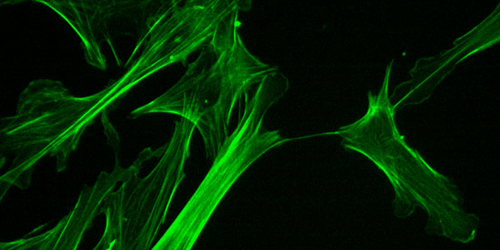Filaments Move Quickly Through a Crowd
Nearly every cell in our bodies has a shape-giving cytoskeleton made up of a dynamic network of self-propelled protein filaments. The movement of these filaments guides important cellular functions, but models fail to describe how they diffuse and travel in a crowded environment. Computer simulations by Suvendu Mandal at Heinrich Heine University Düsseldorf, Germany, and colleagues now show that the more densely packed the filaments, the faster their overall diffusion [1]. This counterintuitive finding may provide a tool for controlling the mobility of self-propelled agents by tuning the degree of crowding.
The researchers simulate semidilute solutions of stiff, self-propelled filaments. Between collisions with their neighbors, each filament “swims” at a constant velocity along the direction of its long axis, but this direction shifts as the filament changes its orientation. Varying the number density of filaments in the simulation, Mandal and colleagues find that in a crowded environment, interactions between filaments suppress their freedom to rotate. This lack of rotation means that filaments maintain more constant swimming directions, leading to an overall increase in diffusion. The researchers show that crowding can enhance the overall diffusion by more than an order of magnitude compared to less crowded situations. The approach generalizes to nonequilibrium states the well-established “tube model.” In this picture, the motion of a non-self-propelled filament is restricted to a tube because of the filament’s entanglements with its neighbors.
The findings lay a foundation for understanding transport in real biological systems such as cell interiors, soils, and biofilms. They could also inspire new ways of studying complex heterogeneous media that host agents of multiple types and sizes.
–Rachel Berkowitz
Rachel Berkowitz is a Corresponding Editor for Physics Magazine based in Vancouver, Canada.
References
- S. Mandal et al., “Crowding-enhanced diffusion: An exact theory for highly entangled self-propelled stiff filaments,” Phys. Rev. Lett. 125, 138002 (2020).




